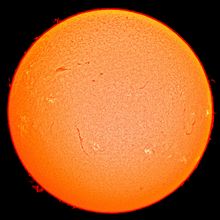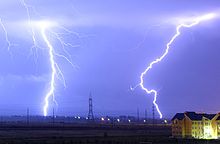 Energy
Energy
In physics, energy is a property of objects which can be transferred to other objects or converted into different forms.[1] The "ability of a system to perform work" is a common description, but it is misleading because energy is not necessarily available to do work.[2] For instance, in SI units, energy is measured in joules, and one joule is defined "mechanically", being the energy transferred to an object by the mechanical work of moving it a distance of 1 metre against a force of 1newton.[note 1] However, there are many other definitions of energy, depending on the context, such as thermal energy, radiant energy, electromagnetic, nuclear, etc., where definitions are derived that are the most convenient.
 Some types of energy are a varying mix of both potential and kinetic energy. An example is mechanical energy which is the sum of (usually macroscopic) kinetic and potential energy in a system. Elastic energy in materials is also dependent upon electrical potential energy (among atoms and molecules), as is chemical energy, which is stored and released from a reservoir of electrical potential energy between electrons, and the molecules or atomic nuclei that attract them..The list is also not necessarily complete. Whenever physical scientists discover that a certain phenomenon appears to violate the law of energy conservation, new forms are typically added that account for the discrepancy.
Some types of energy are a varying mix of both potential and kinetic energy. An example is mechanical energy which is the sum of (usually macroscopic) kinetic and potential energy in a system. Elastic energy in materials is also dependent upon electrical potential energy (among atoms and molecules), as is chemical energy, which is stored and released from a reservoir of electrical potential energy between electrons, and the molecules or atomic nuclei that attract them..The list is also not necessarily complete. Whenever physical scientists discover that a certain phenomenon appears to violate the law of energy conservation, new forms are typically added that account for the discrepancy.
Heat and work are special cases in that they are not properties of systems, but are instead properties of processes that transfer energy. In general we cannot measure how much heat or work are present in an object, but rather only how much energy is transferred among objects in certain ways during the occurrence of a given process. Heat and work are measured as positive or negative depending on which side of the transfer we view them from.

Potential energies are often measured as positive or negative depending on whether they are greater or less than the energy of a specified base state or configuration such as two interacting bodies being infinitely far apart. Wave energies (such as radiant or sound energy), kinetic energy, and rest energy are each greater than or equal to zero because they are measured in comparison to a base state of zero energy: "no wave", "no motion", and "no inertia", respectively.
The distinctions between different kinds of energy is not always clear-cut. As Richard Feynman points out:
Some examples of different kinds of energy:
| Type of energy | Description |
|---|---|
| Kinetic | (≥0), that of the motion of a body |
| Potential | A category comprising many forms in this list |
| Mechanical | The sum of (usually macroscopic) kinetic and potential energies |
| Mechanical wave | (≥0), a form of mechanical energy propagated by a material's oscillations |
| Chemical | that contained in molecules |
| Electric | that from electric fields |
| Magnetic | that from magnetic fields |
| Radiant | (≥0), that of electromagnetic radiation including light |
| Nuclear | that of binding nucleons to form the atomic nucleus |
| Ionization | that of binding an electron to its atom or molecule |
| Elastic | that of deformation of a material (or its container) exhibiting a restorative force |
| Gravitational | that from gravitational fields |
| Rest | (≥0) that equivalent to an object's rest mass |
| Thermal | A microscopic, disordered equivalent of mechanical energy |
| Heat | an amount of thermal energy being transferred (in a given process) in the direction of decreasing temperature |
| Mechanical work | an amount of energy being transferred in a given process due to displacement in the direction of an applied force |
No comments:
Post a Comment